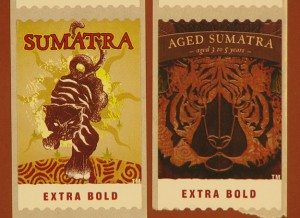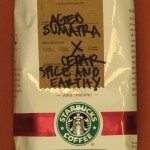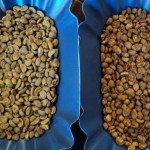
The endangered Sumatran tiger roams – close to near extinction – on this hot, moist, tropical island where lush Sumatran pines, rhododendron, and bamboo color the landscape. This small Indonesian island is the birthplace of Sumatra coffee, processed, and created in a unique way steeped in tradition, and un-replicated anywhere else in the world.
Coffee trees in Sumatra grow on small farms at high altitudes from above 3000 feet to even 6000 feet and harvested from about May to October. For a comparison of the altitude, if a Seattlelite drives east over Snoqualmie Pass the summit of the pass is at about 3000 feet. This would be the very starting point of the growing region. The many farmers of Sumatra have very small farms, with the average farm only having about 200 trees on it. This tiny in comparison to many areas in Latin America where it would not be surprising to encounter a farm with 2,000 coffee trees. One coffee tree at harvest time produces enough coffee cherries for about one pound of beans. Next time you walk into a Starbucks and look at the coffee wall, imagine one tree for every bag of coffee on the wall, and all the work that went in to getting the coffee bean from tree to the shelf at Starbucks.
A family then harvests their lot of 200 so trees together, with perhaps 4 or 5 heads working to pluck off the ready coffee cherries for processing. Imagine the coffee cherry like a peach (though a peach is much larger) and so you have a sticky, moist, wet fruit over the hard bean/seed center which the family want to get at. The next step is called “de pulping” which is the process of removing the outer layer of fleshy cherry from the coffee seed. I found a you-tube video showing this exact process here. Because the island of Sumatra uses a very manual process, the depulping mill may be shared among several farms or a community, and the leaders of the community arrange for it to be borrowed by a family on harvest day. The depulping of the coffee cherry should occur within 24 hours of harvest because a cherry left unpulped for too long may rotten and spoil leaving an undesirable flavor in the coffee.
The coffee cherries are processed through the depulpers, and out of one side of the pulping mill there is now a pile of sticky, parchment enclosed coffee beans, and the other side has wet fruit. This is very different than in Latin America where the depulping mills may be very large sophisticated automatic machines. De-pulping usually is an old wooden hand-cranked depulping machine.
The family picks up, by handfuls, the coffee cherry (still covered with remnants of sticky fruit and parchment) and manually simply passes them through a series of buckets of water to attempt to remove some of the stickiness of the coffee cherry. This is done carefully, handful by handful, with no automation at all. In contrast, in Latin America the coffee beans may actually be fully washed at this stage in large vats of water, rather than briefly passing through a few buckets by hand.
Next the coffee beans are dried to about 30% moisture on tarps for a few hours before collected and hauled to a co-op mill for wet hulling. The purpose of hulling is to remove more of the mucilage as well as the parchment over the bean. The coffee beans have a thin parchment layer, much like a peanut has a thin parchment around it. In some growing regions, the hulling is done on the dry bean, but in Sumatra the bean still retains much moisture, and they’re white in color, and have a rubbery softness to them. The hulling machine rips off the parchment from the coffee bean. This 30% percent moisture level of the bean means that the bean still is semi-wet, and retains about 30% of its moisture.
The next step in the process involves a final stage of drying, after the hulling, which may last from just a few days to a full week depending on whether the sunshine is shining brightly on the island, or if it is raining. The farmer and his family carefully lay out the coffee beans on some tarps in the backyard of their farm for a period of drying. If it rains, the family is on the alert and must run out and cover their coffee beans.
The family is now waiting for the coffee beans to get to about 12 percent moisture level before removing them from the tarps. In other growing regions, some farmers may have special tools or equipment designed to measure the moisture content of the coffee beans at various stages in this process, but in Sumatra, there are no measuring tools of any kind. The farmers just “know” when it is time to move on to the next step. They know because they’ve learned it all slowly on the farm, and they have some intuitive sense at each stage of the process. In Latin America, you might even find farms with a mechanical dryer to speed this process up. The coffee beans can easily be spoiled and produce an off-taste at any stage if the beans do not dry enough or are over-dried. It is truly remarkable that the Sumatran farmer just “knows” when it is time for the next step in the processing of the coffee bean.
The farmer and his family collect the beans and package them into burlap bags to ready them for shipment around the world. Some farmers working with Starbucks may send small samples of the beans to Lausanne, Switzerland, where Starbucks has a central location for global green bean sourcing. As mentioned before, in Sumatra, coffee is produced through thousands of very small farms, usually less than one hectre in size. In 2008, there were 24,516 family farms on Sumatra participating in C.A.F.E. practices. For more information about Starbucks coffee sourcing practices, visit their Shared Planet report.
This unique process of process of sourcing coffee from Sumatra has never been replicated in any part of the world to create the same flavor profile as the Sumatra coffee bean – its hallmark is a deep earthy quality, full-bodied, with notes of mushrooms and butter. The green beans are roasted become the Starbucks Sumatra coffee that we customers know and love.
However the story of Starbucks Sumatra coffee is not over. Many thousands of pounds of Sumatra coffee are purchased by Starbucks, and some lots of it are designated for shipment to Starbucks partners in Singapore for the “aging” phase of the coffee. The burlap coffee bags are loaded onto a boat, and sent to Singapore where Starbucks has a special warehouse for the coffee to age three to five years. The warehouse is secure building designed with numerous upper level open windows for the tropical winds to waft through and work their magic on the beans. Singapore partners store the burlap bags of beans on palettes stocked extremely high, yet 4 times a year the bags are inspected, vacuumed, and flipped for proper aging. Once every six months the whole palette of beans goes through a rotation so that the beans that were on the top are now on the bottom, and vice versa. The Singapore Starbucks partners remove samples of the beans once every six months, and send these samples to Starbucks partners in Seattle, Washington, to check the aging process and determine when the beans are ready for roasting.
There is a risk that some of the beans will be ruined; they may turn rancid or never produce a the high-quality beautiful spicy note that Aged Sumatra is known for. The unusual spicy flavor of Aged Sumatra comes from this magical process of time (years), care, and tropical Singapore winds. When several lots are ready for roasting a production they are blended together to create the perfect combination of flavors. A lot of Starbucks Aged Sumatra may be as much as 40,000 pounds of coffee beans. In 2008, Starbucks sourced about 120,000 pounds (3 lots) of Aged Sumatra which then became the key magical ingredients in Starbucks Anniversary Blend Coffee, Starbucks Christmas Blend Coffee, Seattle’s Best Autumn Reserve Coffee, and sometimes sold as small-batch “Aged Sumatra” either in Clover stores or in limited quantities in a Starbucks coffeehouse. All Starbucks coffees featuring a blend that includes Aged Sumatra are blended post-roasting. In other words, the Aged Sumatra beans are roasted separately from other beans and then blended with other beans in huge spinning mixer machines, and then packaged into flavor-lock packaging.
The coffee beans have turned a very light brown from the process of aging for years. They are brown before roasting, unlike an un-aged coffee bean which is green at the time of roasting. One can easily see the difference in the beans in the photo here of the 2 pre-roasted Sumatra beans in the blue bins (Aged Sumatra is on the right). For a larger picture of the pre-roasted Starbucks Sumatra beans, click here. And for a close-up pic of the pre-roasted Aged Sumatra beans click here. For comparison, click here for a close up of the green, un-aged, Sumatra coffee beans. As I write this blog entry, currently Aged Sumatra is available for purchase as a small-batch coffee in Starbucks Clover stores. Currently the packaging of the Aged Sumatra is simply the standard Clover small batch packaging which is in a plain white bag with a brown name sticker, and a red stripe around the bag. The reverse side of the Aged Sumatra packaging, like in the case of all the small-batch Starbucks coffee offerings, includes the date that the coffee was roasted. Click here for a picture of the reverse side of the bag.
If anyone knows of any errors in the above information, please contact me. Thank you again to Larry Aldrich of Seattle Custom Framing for assisting me with a number of photos used in this blog entry.


Related posts
20 Comments
Leave a Reply Cancel reply
You must be logged in to post a comment.
Sponsors
Recent Comments
- DEVIN on Compostable Straws Land in Seattle Starbucks Stores
- coffeebeanz on Why do you go to Starbucks less often? (If that’s true for you)
- Willi on You can now buy a Siren statue: $6,000
- Willi on A major revamp of your drink recipe: Testing syrup extracts and cane sugar
- Skip on Why do you go to Starbucks less often? (If that’s true for you)






Great article Melody! I definitely learned a thing or two!
Reading these types of articles are what really gets me interested in coffee. I love love love love love this article. My black apron seminar was done on Sulawesi, and I remember reading about those manual de-pulping machines. Interesting fact about the hand washing of them in buckets!
Great blog entry Melody! I learned quite a bit! I’ve always wanted to try aged Sumatra and I’ve been watching for it for a couple years now, and I’ve never seen it. I’m thinking it’s not sold in Canada.
WoW! What GREAT info!
Hi GAStarbucksGirl – Thank you so much for commenting on the Sumatra/Aged Sumatra blog post. It is by far my favorite! I almost think it should be required reading material for baristas! 😉
Your whole blog should be required reading!
I talked to a customer about aged beans today! Fun, fun!
I *HAVE* to go get some of the sumatra now…I’ve always loved sumatra but it’s been too long since I’ve had some. Then reading about the roasting process for the regular and the aged…*BIG SMILE* I’m thinking that reading a fellow coffee lovers blog is good…definately fueling my tastebuds for more of the dark liquid goodness! Thank you for sharing 😀
Thanks for your information..
I have a deeply understanding of Aged Suamtra;
From
Grand Gateway No.2 store of Shanghai China Starbucks parteners
Tim Xue
Melody,
Thanks for this information, very helpful and well documented. I am working (slowly) through the coffee masters program and this puts the information in a condensed format with visuals! Well done.
I think part of the miracle is that given the whole process, CAFE practices and all the people involved that you can still get a cup for less than $2.
It’s interesting topic about Sumatra Coffee, I know a lot about sumatra, especially in the north of sumatra, because my parent was born there, and our village have a lot plant for coffee and pineapple.
Sumatra is part of indonesia country, not come from Singapore…so that it’s so funny when i reading the description about Sumatra Coffee…because i found a sentence “The unusual spicy flavor of Aged Sumatra comes from this magical process of time (years), care, and tropical Singapore winds”?????? How come….he..he..he…
It’s better to come to indonesia as a source of sumatra coffe (Sumatra is indonesian island), you will find a lot of coffee with different taste..
I hope the description about sumatra coffee is not too far away from the fact..
Thanks for a great article which was a real eye opener for me. I am not a particularly knowledgeable coffee person, but Sumatra is my coffee of choice, and the type to which any others I might try get compared, usually, for me, unfavorably. Not so Anniversary Blend, I loved it…told my hubby it tasted like a good Sumatra, a comment intended as high praise, not as a comment on origin. My tongue wasn’t far off it seems and kudos on whatever the other beans were that blended so subtly in that magic mix.
@B’racha – Welcome to the site! Glad I could help you understand what makes Anniversary Blend so delightful! 🙂 Come back soon. Tomorrow I’m posting a blog post on Sumatra-Siborong-Siborong
Hai… nice to meet you all (i’m a newbie here). i’m from Indonesia, and i’m so glad that you like Indonesian coffee. Just a little information about aged coffee, if you ever got any chance coming to Bandung (west java capital city), you should try “Kopi Aroma”. It’s a coffee shop where all you can find (and i mean it ALL) is an aged coffee. Range from 7 to 8 years old. I’m still a big fan of starbucks, but if you got any chance, you should try this coffee shop. Godspeed.
Seriously Mel…you are amazing!! I learned more from this blog than I have in my last 7 years at starbucks. I’m also a coffee master- this is so interesting, thank you!!
Hi Kristin – Thank you for the props! When I wrote this article, I got help from a wise Starbucks partner and didn’t do it all myself. I didn’t know all that info when I started, but I did manage to put it all together here!
I have been a avid Sumatra drinker for about 2 years. I buy about 15 lbs every 3 months. I have been in love with this coffe. But I bought 12 lbs a couple of weeks ago and something is wrong. It is terrible. The flavor is not bold at all. I have opened 4 lbs trying to get it right. They have made a big mistake or have changed something. If anyone can tell me what is going on please do. I will have to find another brand at this pace.
rick:
We agree – something definitely HAS changed for the Summatra Ground since the introduction of new packaging… While there are several Starbucks in our area, we usually pick-up the product at Publix Supermarket… Will have to ask Starbuck’s directly!
So after aging in singapore, where do the coffee beans go for roasting?
Great article on one of my FAVORITE coffees that makes up the magical Christmas blend that I love so much I stockpile it and have it on hand til at least July each year. So much diligence and detail is given to the aging of these beans and I am in awe at the process it goes through to reach my cup.